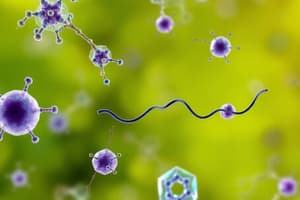Podcast
Questions and Answers
What is the main function of the structure of DNA?
What is the main function of the structure of DNA?
- To provide structural support to cells.
- To facilitate the storage of genetic information. (correct)
- To catalyze biochemical reactions.
- To enable protein synthesis directly.
Which level of protein structure involves the sequence of amino acids?
Which level of protein structure involves the sequence of amino acids?
- Tertiary Structure
- Secondary Structure
- Quaternary Structure
- Primary Structure (correct)
What mechanism is primarily responsible for regulating metabolic pathways?
What mechanism is primarily responsible for regulating metabolic pathways?
- Competitive inhibition
- Feedback inhibition (correct)
- Gene expression modulation
- Enzyme activation
In biochemical techniques, what is the primary use of chromatography?
In biochemical techniques, what is the primary use of chromatography?
Which aspect of protein structure is defined by the interactions between multiple polypeptide chains?
Which aspect of protein structure is defined by the interactions between multiple polypeptide chains?
Which biomolecule is primarily responsible for storing genetic information?
Which biomolecule is primarily responsible for storing genetic information?
What is the primary role of enzymes in biochemical reactions?
What is the primary role of enzymes in biochemical reactions?
Which statement best describes catabolism?
Which statement best describes catabolism?
Which type of carbohydrate is specifically a simple sugar?
Which type of carbohydrate is specifically a simple sugar?
What role does ATP play in metabolic processes?
What role does ATP play in metabolic processes?
Which of the following statements about lipids is true?
Which of the following statements about lipids is true?
Which structure of proteins is primarily determined by the sequence of amino acids?
Which structure of proteins is primarily determined by the sequence of amino acids?
Which of the following factors can affect enzyme activity?
Which of the following factors can affect enzyme activity?
Flashcards
Primary Structure
Primary Structure
The sequence of amino acids in a polypeptide chain.
Tertiary Structure
Tertiary Structure
The three-dimensional shape of a polypeptide chain, formed by interactions between amino acids.
Feedback Inhibition
Feedback Inhibition
A key regulatory mechanism in which the product of a metabolic pathway inhibits an earlier step in the pathway.
Bioenergetics
Bioenergetics
Signup and view all the flashcards
Chromatography
Chromatography
Signup and view all the flashcards
What is biochemistry?
What is biochemistry?
Signup and view all the flashcards
What are proteins?
What are proteins?
Signup and view all the flashcards
What are Carbohydrates?
What are Carbohydrates?
Signup and view all the flashcards
What are Lipids?
What are Lipids?
Signup and view all the flashcards
What are Nucleic Acids?
What are Nucleic Acids?
Signup and view all the flashcards
What is metabolism?
What is metabolism?
Signup and view all the flashcards
What are enzymes?
What are enzymes?
Signup and view all the flashcards
What is Cellular Respiration?
What is Cellular Respiration?
Signup and view all the flashcards
Study Notes
Introduction to Biochemistry
- Biochemistry is the study of chemical processes within and relating to living organisms.
- It includes the structure and function of biomolecules, metabolic pathways, and the regulation of cellular processes.
- Biomolecules, including proteins, carbohydrates, lipids, and nucleic acids, are central to understanding life's processes.
Biomolecules
- Proteins: Complex macromolecules composed of amino acids linked by peptide bonds.
- Exhibit diverse structures (primary, secondary, tertiary, quaternary).
- Perform various functions (enzymatic activity, structural support, transport).
- Carbohydrates: Organic compounds (carbon, hydrogen, oxygen, often 1:2:1 ratio).
- Classified as monosaccharides, disaccharides, and polysaccharides.
- Crucial for energy storage and structure.
- Lipids: Diverse hydrophobic molecules (fats, phospholipids, steroids).
- Primarily composed of carbon, hydrogen, and oxygen.
- Vital for energy storage, membrane structure, and hormone synthesis.
- Nucleic Acids: Polymers composed of nucleotides.
- DNA and RNA are essential for genetic information storage and transfer.
- DNA stores genetic information; RNA plays a role in protein synthesis.
Metabolism
- Metabolism encompasses all chemical reactions within a cell or organism.
- Catabolism: Breakdown of complex molecules into simpler ones, releasing energy.
- Anabolism: Synthesis of complex molecules from simpler ones, needing energy.
- Metabolic pathways involve interconnected, enzyme-catalyzed reactions.
- Energy transfer is key; ATP is the primary energy currency.
Enzymes
- Enzymes are biological catalysts.
- Enzymes speed up reactions without being consumed.
- Enzymes display substrate specificity, binding to specific substrates.
- Enzyme activity is influenced by temperature, pH, and other factors.
Cellular Respiration
- Cellular respiration is a metabolic process converting nutrient energy into ATP, with waste products released.
- Glycolysis, Krebs cycle, and electron transport chain are key steps.
- Essential for energy production in cells.
Protein Structure and Function
- Primary Structure: Amino acid sequence.
- Secondary Structure: Localized repeating structures (alpha-helices, beta-sheets).
- Tertiary Structure: Three-dimensional shape of a polypeptide chain.
- Quaternary Structure: Arrangement of multiple polypeptide chains.
- Protein function is directly related to protein structure.
Nucleic Acid Structure and Function
- DNA's double helix structure facilitates genetic information storage.
- RNA's single-stranded nature facilitates diverse roles in protein synthesis and regulation.
Regulation of Metabolic Pathways
- Metabolic pathways maintain cellular homeostasis through regulation.
- Feedback inhibition is a key regulatory mechanism.
- Hormones and other signaling molecules also modulate metabolic processes.
Other Important Concepts in Biochemistry
- Bioenergetics: Study of energy flow in biological systems.
- Thermodynamics: Principles governing energy changes in reactions.
- Buffer systems: Maintain stable pH within cells.
- Acid-base chemistry: Crucial for cellular processes.
- Molecular interactions: Understanding of how molecules interact in living systems is critical for biological function.
Techniques in Biochemistry
- Spectrophotometry
- Chromatography
- Electrophoresis
- X-ray crystallography
- These techniques are used for analyzing biological molecules and systems.
Studying That Suits You
Use AI to generate personalized quizzes and flashcards to suit your learning preferences.




